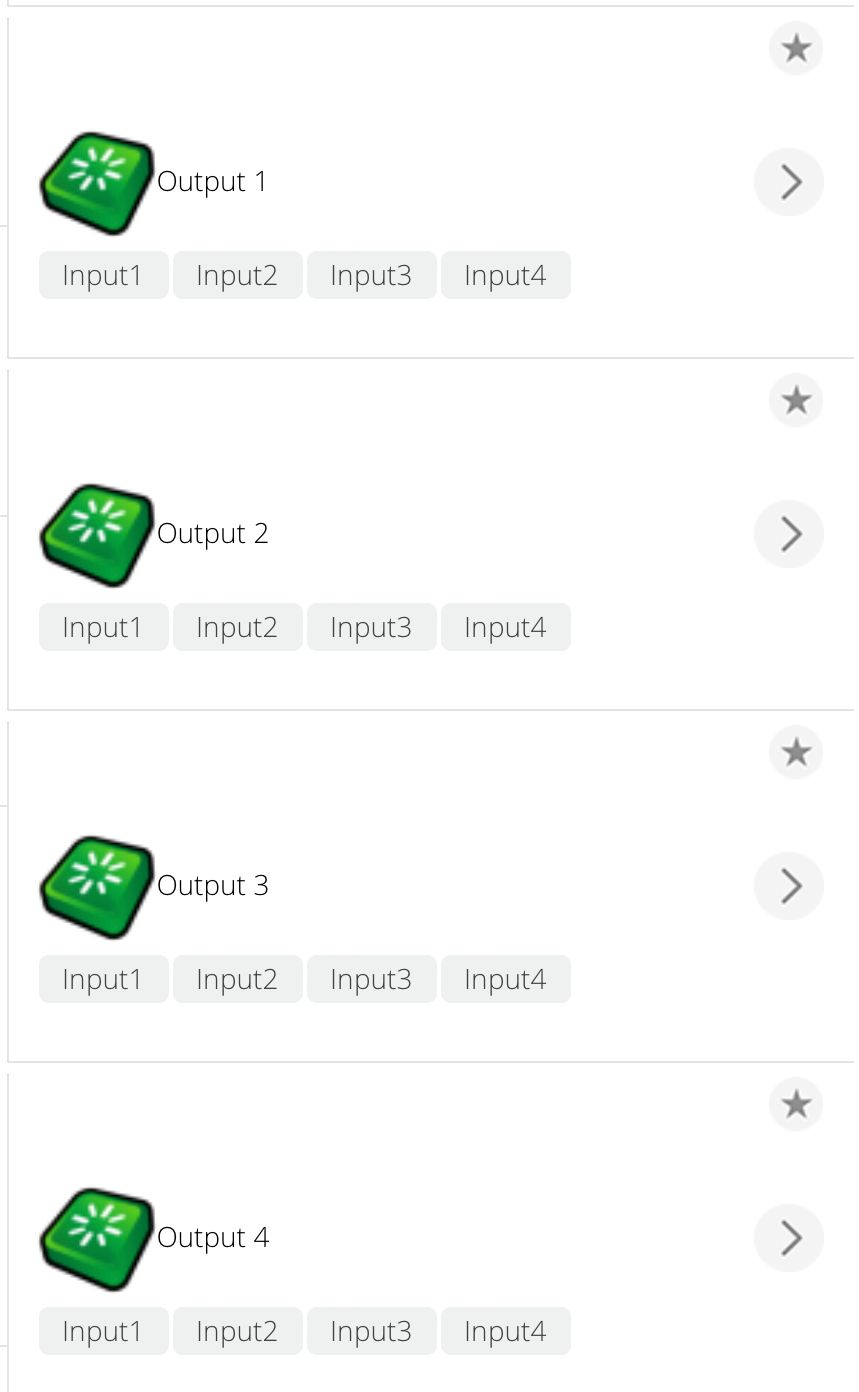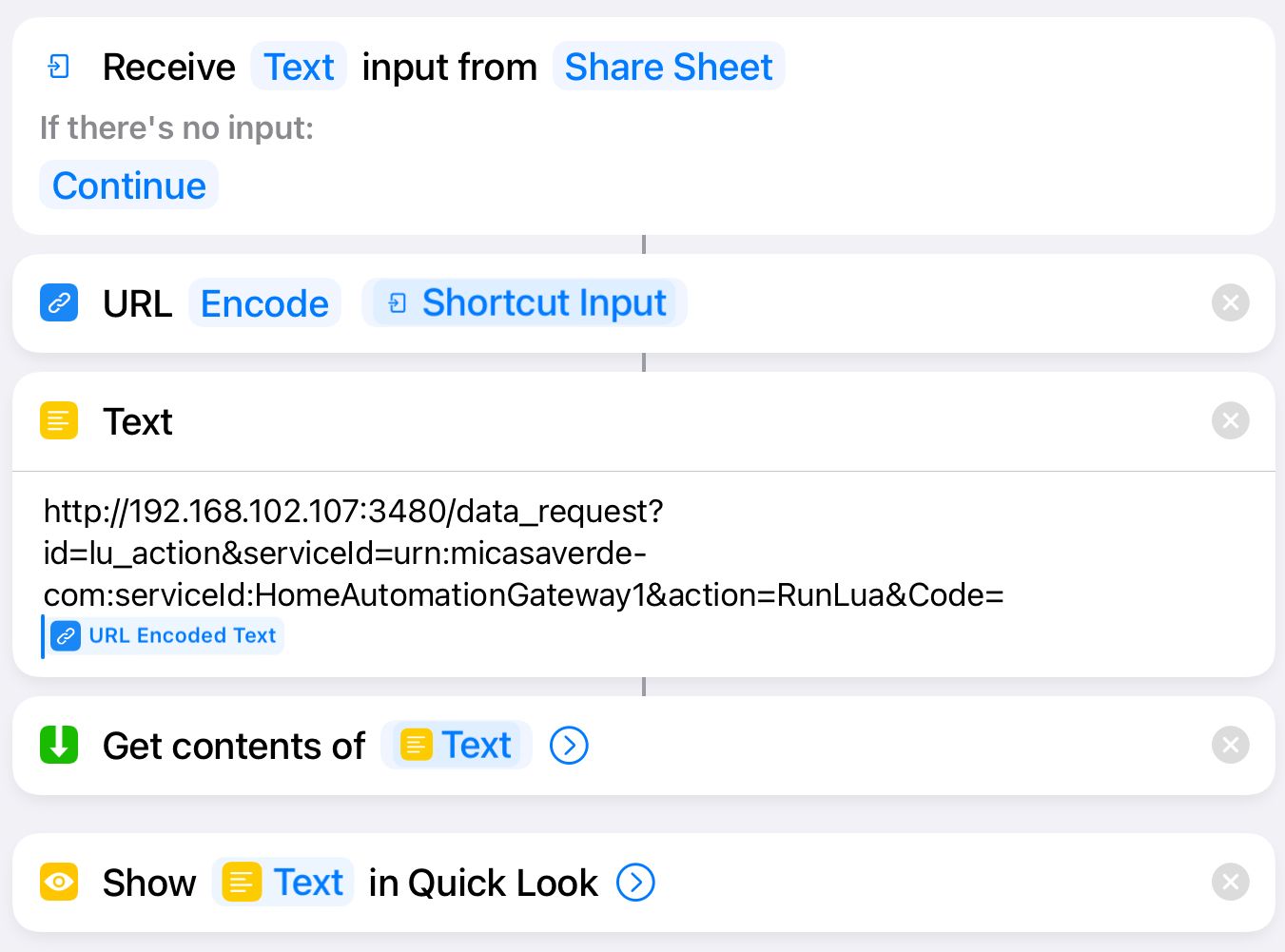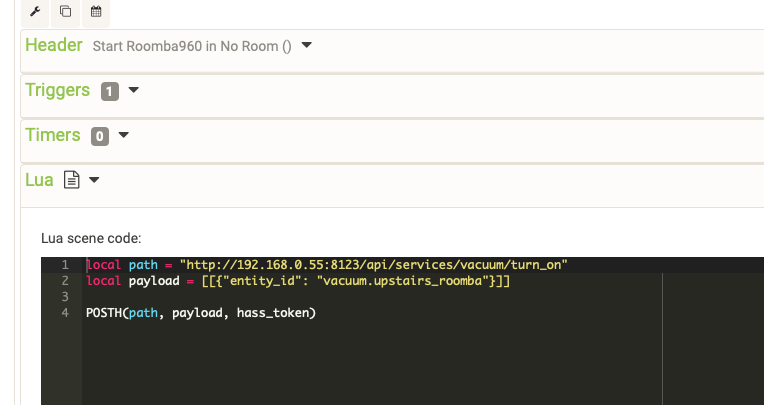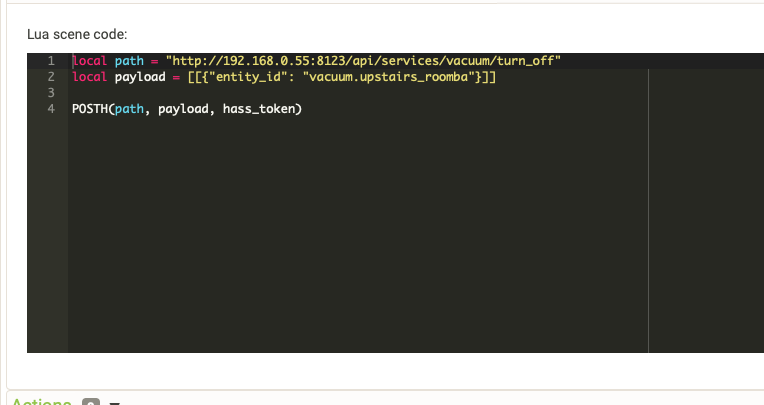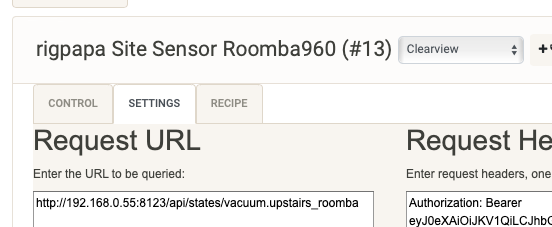Roomba integration through Hass
-
Responding to @PrincessClevage's request through a PM,
I am posting my Roomba integration:
First of course you will have to have Home Assistant installed and running. I will not be covering that.
Then you will need to add and configure the roomba component which can now be done through the UI
I won't cover this either.
Next, on Vera or openLuup, I used a sitesensor with the following configuration:
I also have a preset function loaded in my startup lua to directly send post commands to my home assistant instance which I posted here:
https://smarthome.community/topic/39/lua-function-in-openluup-startup-lua-to-send-async-command-to-home-assistant-apiwhich then enables me to create a variety of scenes triggered by the site sensor: For example disarming the site sensor docks the roomba by creating a variable watch on the arm status of the site sensor and then run this code:
Likewise I can get it to start cleaning from openLuup through a similar scene
And you can let wild of your creativity from there... I have an identical integration for the xiaomi robot and am tuning the vacuum noise according to whether I am on the same floor while the robot is cleaning...
-
Responding to @PrincessClevage's request through a PM,
I am posting my Roomba integration:
First of course you will have to have Home Assistant installed and running. I will not be covering that.
Then you will need to add and configure the roomba component which can now be done through the UI
I won't cover this either.
Next, on Vera or openLuup, I used a sitesensor with the following configuration:
I also have a preset function loaded in my startup lua to directly send post commands to my home assistant instance which I posted here:
https://smarthome.community/topic/39/lua-function-in-openluup-startup-lua-to-send-async-command-to-home-assistant-apiwhich then enables me to create a variety of scenes triggered by the site sensor: For example disarming the site sensor docks the roomba by creating a variable watch on the arm status of the site sensor and then run this code:
Likewise I can get it to start cleaning from openLuup through a similar scene
And you can let wild of your creativity from there... I have an identical integration for the xiaomi robot and am tuning the vacuum noise according to whether I am on the same floor while the robot is cleaning...
@rafale77
Is it possible that site sensor can also send the command to Roomba without home assistant? -
It probably is possible but I never looked at the API itself. Home Assistant is too convenient as a bridge to many other APIs piping through its own API into openLuup... Actually I have not even found the documentation for it.
Edit: It isn't an open API so it is not documented...
https://homesupport.irobot.com/app/answers/detail/a_id/9840/p/4116/kw/API
-
It probably is possible but I never looked at the API itself. Home Assistant is too convenient as a bridge to many other APIs piping through its own API into openLuup... Actually I have not even found the documentation for it.
Edit: It isn't an open API so it is not documented...
https://homesupport.irobot.com/app/answers/detail/a_id/9840/p/4116/kw/API
@rafale77
I am really trying to avoid having multiple units to manage home automation e.g this hub bridges to that device which then executed on another and I really only have time to put effort into one device. I have read this forum but what is presented here would be way past the average joe (not that it is aimed at the average joe). So far I have been able to contain all my automation in Vera and Alexa/google home and use firewalla/pihole for security / privacy which is working well but I can see the lack of the current Vera evolving a problem for the future and curious what options are out there, that also help keep as many much as possible local -
@rafale77
I am really trying to avoid having multiple units to manage home automation e.g this hub bridges to that device which then executed on another and I really only have time to put effort into one device. I have read this forum but what is presented here would be way past the average joe (not that it is aimed at the average joe). So far I have been able to contain all my automation in Vera and Alexa/google home and use firewalla/pihole for security / privacy which is working well but I can see the lack of the current Vera evolving a problem for the future and curious what options are out there, that also help keep as many much as possible localUnfortunately at this point there is no commercial offering which can cover absolutely everything.
The closest platform to doing this that I know of is actually home assistant which is open source and as I explained here:https://smarthome.community/topic/123/the-home-automation-controller-pyramid
Even IT often needs to be paired with something else to be fully complete. Some people are content with some compromises they have to make with the platform they have chosen: For home assistant, it is currently a slightly lacking zwave support and a not so easy and complete automation builder which is why people are running it either with node-red or like most of us here, with openLuup and are living with their zwave support or bridging it to hubitat, homeseer or for some, with vera. It is however the fastest and most complete local API integration hub...
All others are good at one thing and not at others. Vera was very innovative with their lua logic and plugin layer but were catastrophic at RF network management. Homeseer are very good at network management but lack zigbee and are expensive. Hubitat is very good overall for device management but lacks some cross platform and API integration...
OpenLuup offers the advantage of being very transparent to vera. It runs all the same plugins, scenes and has the same API/logic architecture. It only lacks radio management which is brought it through bridge pluging like zway bridge or vera bridge.
The work required to reverse engineer the home assistant plugin to roomba and make an equivalent for openLuup is possible but to me, it is a lot more work than to install home-assistant and bridge the device through it. It is a lot more efficient also because it opens the door to doing the same thing with all the home-assistant integrations which, let's be honest, we (with openLuup) won't be able to compete with given the relative size of that community and the speed at which they are going. OpenLuup+HomeAssitant+Z-way is the best approach for someone coming from Vera. That's just my opinion...
Besides all three together are a lot less work and a lot less maintenance than vera alone... Infinitely less. That's my experience. Staying with one platform may not be the simplest way to go...

